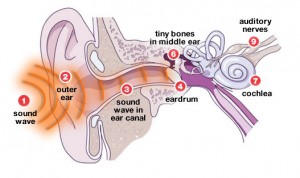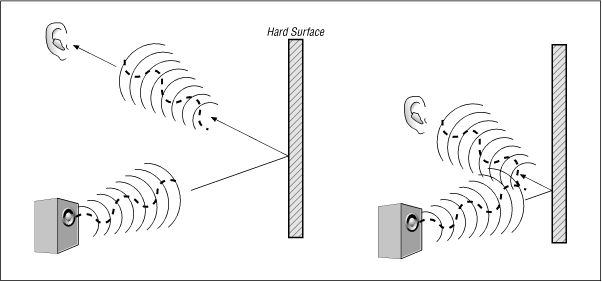Microphone
Transducers, devices that change information from one form to another. A microphone consists of a diaphragm, a magnet, and a coil of wire.  When you speak into it sound waves created by your voice vibrate the diaphragm which is connected to the magnet which is inside the coil of wire. These vibrations cause the magnet to move inside the coil at the same frequency as your voice. A magnet moving in a coil of wire creates an electric current. This current which is at the same frequency as your voice is carried by wires to wherever you wish it to go like an amplifier, transmitter, etc. Once it gets to its destination the process is reversed and it comes out as sound. Speakers basically being the same as microphones.
When you speak into it sound waves created by your voice vibrate the diaphragm which is connected to the magnet which is inside the coil of wire. These vibrations cause the magnet to move inside the coil at the same frequency as your voice. A magnet moving in a coil of wire creates an electric current. This current which is at the same frequency as your voice is carried by wires to wherever you wish it to go like an amplifier, transmitter, etc. Once it gets to its destination the process is reversed and it comes out as sound. Speakers basically being the same as microphones.
Drivers
They are the heart and soul of any speaker system. In a nutshell, these convert an electric signal from the amplifier to audible sound via magnet-driven drivers.
Delay
An audio effect which records an input signal to an audio storage medium, clocked through large banks of RAM memory, and then plays it back after a period of time. The delayed signal may either be played back multiple times, or played back into the recording again, to create the sound of a repeating, decaying echo.
Reverberation
The persistence of sound in a particular space after the original sound is removed. A reverberation, or reverb, is created when a sound is produced in an enclosed space causing a large number of echoes to up build up and then slowly decay as the sound is absorbed by the walls and air. This is most noticeable when the sound source stops but the reflections continue, decreasing in amplitude, until they can no longer be heard in such area as stadiums, halls, other performance areas. The length of this sound decay, or reverberation time, receives special consideration in the architectural design of large chambers, which need to have specific reverberation times to achieve optimum performance for their intended activity.
A spring reverb system uses a transducer at one end of a spring and a pickup at the other, similar to those used in plate reverbs, to create and capture vibrations within a metal spring. Guitar amplifiers frequently incorporate spring reverbs due to their compact construction and low cost.
Screech
This is a special kind of feedback which occurs when a sound loop exists between an audio input (for example, a microphone or guitar pickup) and an audio output (for example, a loudspeaker). In this example, a signal received by the microphone is amplified and passed out of the loudspeaker. The sound from the loudspeaker can then be received by the microphone again, amplified further, and then passed out through the loudspeaker again.
How we hear
When a pressure wave reaches the ear, a series of high and low pressure regions impinge upon the eardrum. The arrival of a compression or  high pressure region pushes the eardrum inward; the arrival of low pressure regions serves to pull the eardrum outward. The continuous arrival of high and low pressure regions sets the eardrum into vibrational motion. This is depicted in the animation below.
high pressure region pushes the eardrum inward; the arrival of low pressure regions serves to pull the eardrum outward. The continuous arrival of high and low pressure regions sets the eardrum into vibrational motion. This is depicted in the animation below.
Since the eardrum is set into vibration by the incoming pressure wave, the vibrations occur at the same frequency as the pressure wave. If the incoming compressions and rarefactions arrive more frequently, then the eardrum vibrates more frequently. This frequency is transmitted through the middle and inner ear and provides the perception of pitch. Higher frequency vibrations are perceived as higher pitch sounds and lower frequency vibrations are perceived as lower pitch sounds.
The intensity of the incoming sound wave can also be transmitted through the middle ear to the inner ear and interpreted by the brain. A high intensity sound wave is characterized by vibrations of air particles with a high amplitude. When these high amplitude vibrations impinge upon the eardrum, they produce a very forceful displacement of the eardrum from its rest position. This high intensity sound wave causes a large vibration of the eardrum and subsequently a large and forceful vibration of the bones of the middle ear. This high amplitude vibration is transmitted to the fluid of the inner ear and encoded in the nerve signal which is sent to the brain. A high intensity sound is perceived as a relatively loud sound by the brain.
TOO LOUD
Noise is harmful. Damage caused by noise can range from bursting of eardrum, permanent hearing loss cardiac and cardiovascular changes, stress, fatigue, lack of concentration, headaches, insomnia, and loss of appetite and much other damage is caused. Harmful effects are there even if you don’t feel you are being disturbed. Psychological disturbances and emotional distress also occur – violent conduct by persons continuously exposed to unbearable noise.
Now the resonant frequency which our body’s response to is 6 Hz, which is undetectable to us and often now a frequency we encounter. More specifically the head can be damage from 13-20Hz and the eyes 35Hz- 75Hz. This is more often encounters from people who are listening to excessive bass, which has a frequency of 25-1000Hz. This sound is barely audible to the human ear but can cause significance and permanent damage to those parts of the body.
The ear is most sensitive to the frequencies of 1000- 5000Hz, which is the mid-range speaker. The dB ranges from 0dB (Threshold of Hearing (TOH)) to 140dB which is the equivalent of standing about 50m from a military jet aircraft as it takes off, anything higher than 140dB will result in instant perforation of eardrum.
However anything over 90dB can cause hearing damage if we are exposed to it for a prolonged period of time.
Safety Precautions
Speakers are build in acoustic casing which absorb most if not all sound to prevent external vibrations which could harm the body.
Users should never place loud music into their ears, equal to about 100 dB. Safe exposure is 25mins, anything above that is considered some form of hearing lost.
The government has established the average level above which noise can damage the human power of hearing – at a daily exposure of 8 hours – at 80 dB(A). At the workplace the average sound level measured over 8 hours may not exceed 85 dB(A). This rule means that for sound levels above 85 dB(A), suitable facilities need to be put in place to reduce the exposure to noise, unless – in view of very high costs, technical problems and such – this cannot reasonable be done.
At a sound level of more than 80 dB(A) the employer must provide hearing protection devices.


1 Comment